Voulez-vous installer WordPress localement sur votre ordinateur Windows ?
En direct sur votre ordinateur, vous permettez de tester les nouvelles fonctionnalités de WordPress, d’apprendre à développer avec WordPress et de créer des sites avant de les migrer vers le serveur réel.
Dans cet article, nous allons vous afficher comment installer correctement WordPress sur un ordinateur Windows en utilisant deux méthodes différentes. Cela fonctionnera avec Windows 8, Windows 10 et d’autres versions de Windows.
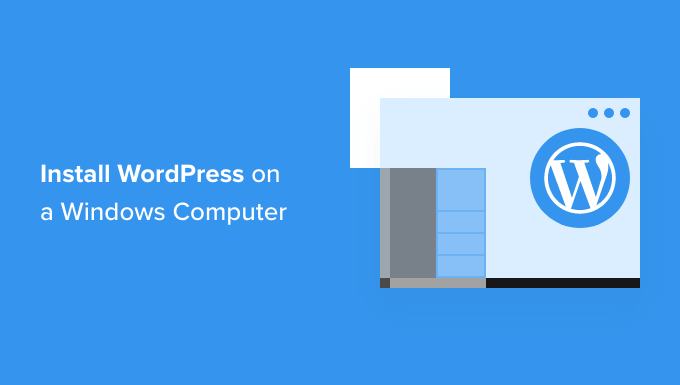
Pourquoi installer WordPress sous Windows ?
L’installation locale de WordPress sur votre ordinateur vous offre un environnement de test qui n’affecte pas votre site ou votre blog en direct. Une installation de WordPress sur votre ordinateur est également appelée serveur local ou localhost.
Normalement, les développeurs/développeuses WordPress utilisent une installation WordPress locale pour développer leurs extensions et thèmes WordPress.
Les utilisateurs/utilisatrices débutant(e)s peuvent également installer WordPress sur leur ordinateur pour s’initier à WordPress, tester de nouveaux thèmes et extensions WordPress, et expérimenter sans affecter un site en direct.
Note : Si vous installez WordPress localement sous Windows, vous êtes la seule personne à pouvoir voir ce site.
Si vous souhaitez créer un site web accessible au public, alors vous devez disposer d’un nom de domaine et d’un hébergeur. Nous vous recommandons de suivre ce guide sur la création d’un blog WordPress.
Ceci étant dit, voyons comment installer correctement WordPress sur un ordinateur Windows. Nous allons vous afficher deux méthodes simples, vous pouvez donc cliquer sur le lien ci-dessous pour passer à la section qui vous intéresse :
- Méthode 1 : Installer WordPress sur Windows en utilisant WordPress local
- Méthode 2 : Installation de WordPress sur Windows avec WampServer
Installer WordPress sur Windows en utilisant le programme d’installation local de WordPress
Local WP, anciennement connu sous le nom de Local by Flywheel, est un logiciel web local qui vous permet d’héberger un site sur votre ordinateur au lieu d’un serveur staging ou live.
Tout d’abord, vous devez télécharger et installer le logiciel Local WP sur votre ordinateur Windows. Il vous suffit de vous rendre sur le site de Local WP et de cliquer sur le bouton « Télécharger gratuitement ».
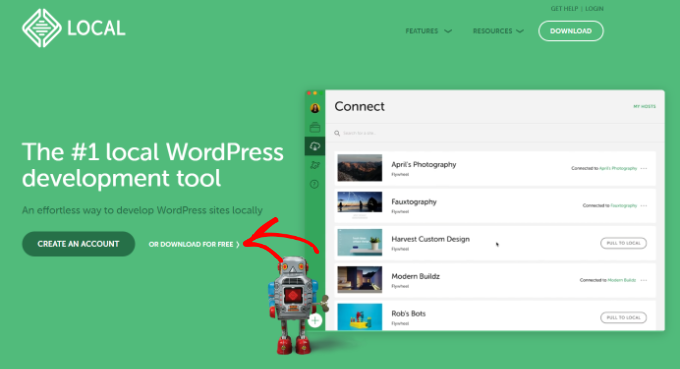
Ensuite, une fenêtre surgissante apparaît dans laquelle vous devez sélectionner votre plateforme.
Choisissez « Windows » dans le menu déroulant.
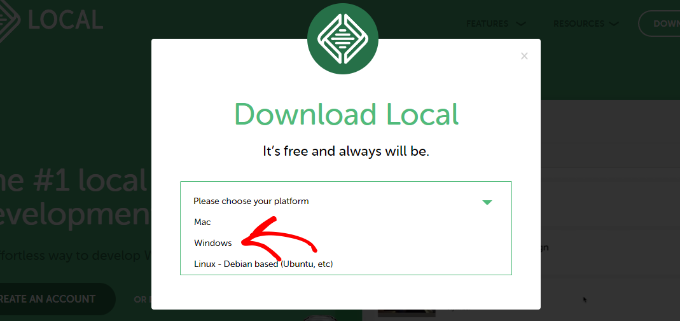
Dernier point, vous pouvez saisir vos coordonnées comme vos nom et prénom, votre adresse e-mail professionnelle et votre numéro de téléphone pour télécharger le logiciel.
Après avoir saisi/saisie les détails, il suffit de cliquer sur le bouton « Get it Now ».
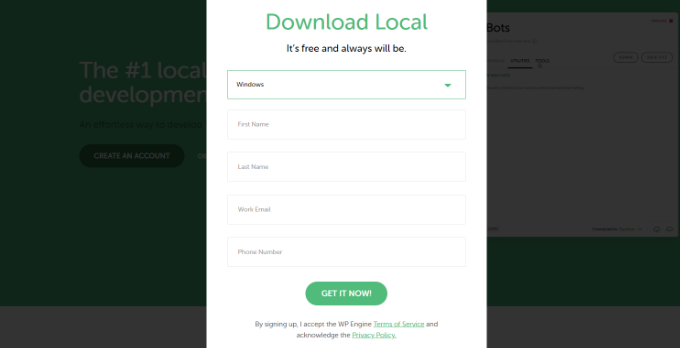
Ensuite, vous pouvez télécharger le logiciel sur votre ordinateur. Une fois téléchargé, lancez l’assistant de configuration.
Vous devez maintenant sélectionner si vous souhaitez installer le logiciel pour tous les utilisateurs/utilisatrices ou uniquement pour vous. Une fois l’option sélectionnée, cliquez sur le bouton « Suivant ».
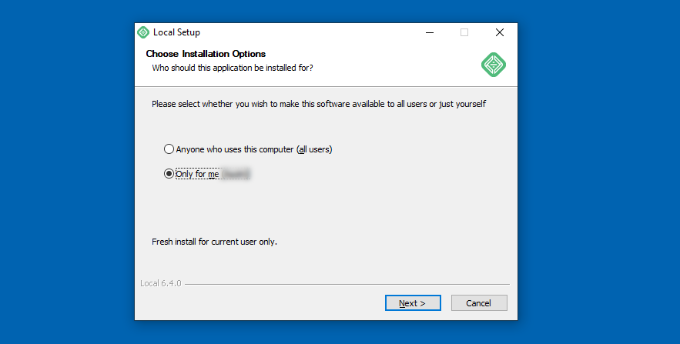
À l’étape suivante, vous pouvez sélectionner le « Dossier de destination » dans lequel le logiciel sera installé.
Il suffit de cliquer sur le bouton « Parcourir » pour définir le chemin d’accès, puis de cliquer sur le bouton « Installer ».
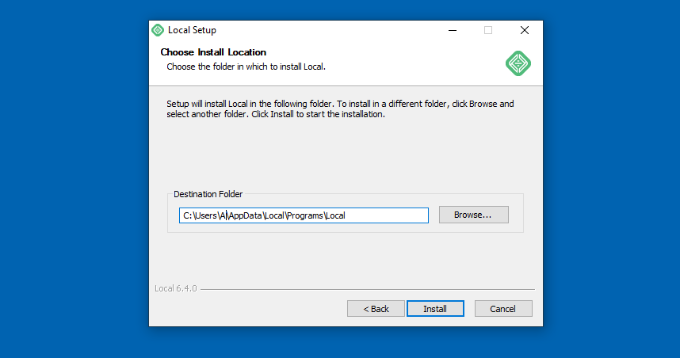
Le logiciel Local WP va maintenant s’installer sur votre ordinateur Windows.
Une fois que c’est fait, vous pouvez cocher la case « Exécuter localement » et cliquer sur le bouton « Terminer » de l’assistant de configuration.
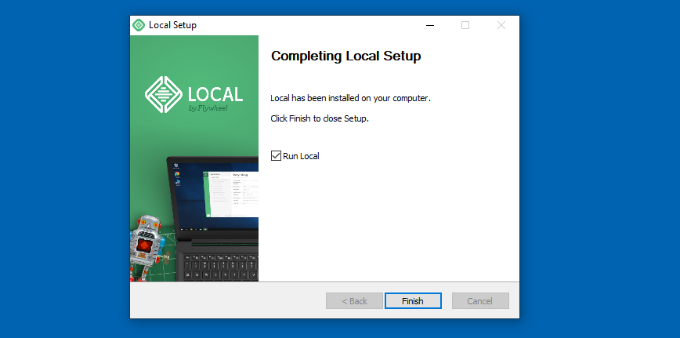
Le logiciel est maintenant lancé sur votre appareil Windows.
L’étape suivante consiste à ajouter un nouveau site local. Pour ce faire, il suffit de cliquer sur le bouton plus (+) en bas.
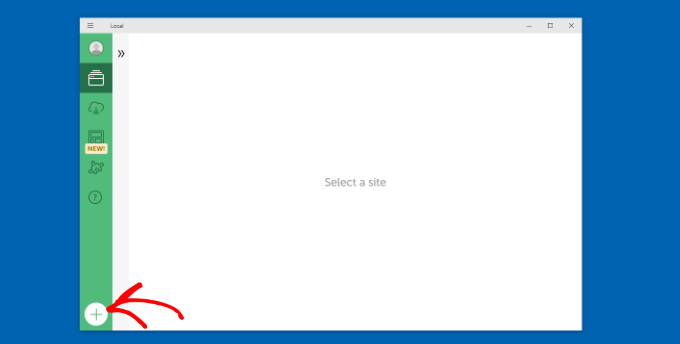
Ensuite, vous pouvez créer un site dans le logiciel local.
Sélectionnez l’option « Créer un nouveau site » et cliquez sur le bouton « Continuer ».
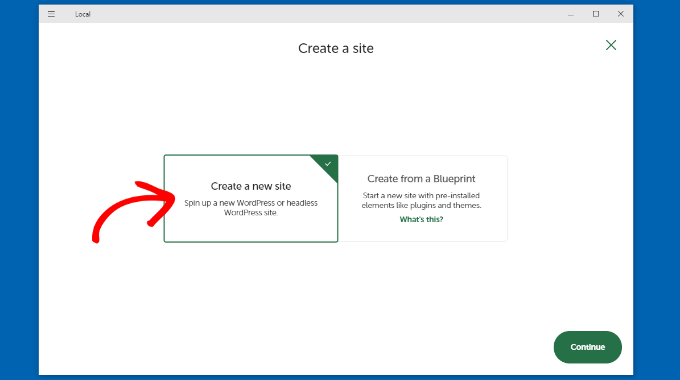
Saisissez ensuite un nom pour votre site local, par exemple wordpresslocalsite.
Il existe également des options avancées qui vous permettent de saisir le domaine et le chemin d’accès du site local. Si vous débutez, nous vous recommandons de conserver les réglages par défaut.
Une fois que vous avez terminé, cliquez simplement sur le bouton « Continuer ».
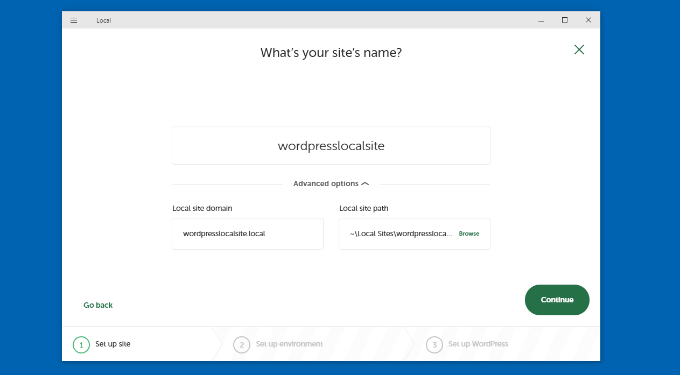
Ensuite, vous devrez choisir un environnement pour votre site local.
Vous pouvez utiliser l’environnement « Sélectionné » dans lequel le logiciel sélectionnera automatiquement la version PHP, le serveur web et la version MySQL. D’autre part, vous pouvez également sélectionner ‘Personnalisé’ et saisir les détails de l’environnement.
Pour ce tutoriel, nous utiliserons les Réglages préférés et cliquerons sur le bouton « Continuer ».
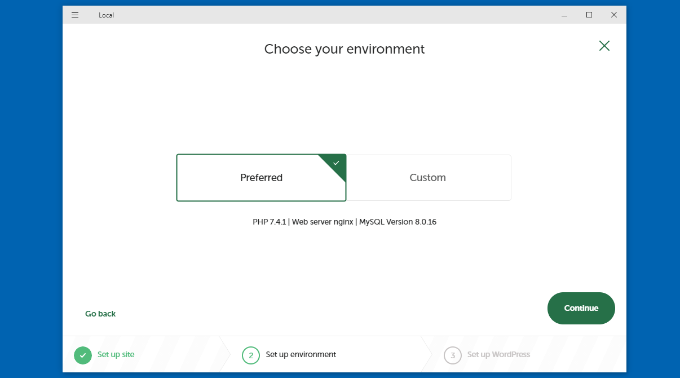
Ensuite, vous pouvez saisir un identifiant et un mot de passe WordPress pour votre site local. Il y a aussi une option pour choisir une adresse e-mail WordPress où vous recevrez toutes les notifications par e-mail.
Il existe également une option avancée dans laquelle le logiciel vous demandera si vous disposez d’un réseau WordPress multisite.
Après avoir saisi/saisie ces informations, il suffit de cliquer sur le bouton « Ajouter un site ».
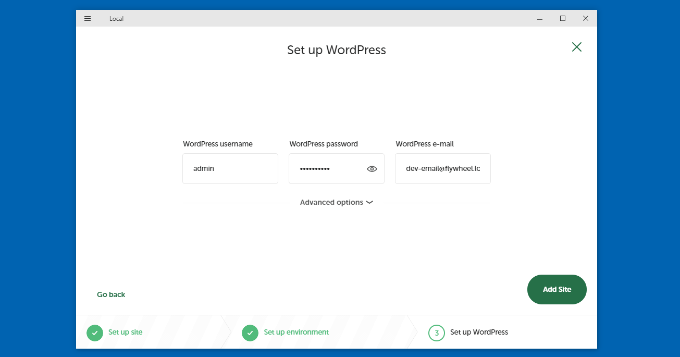
Le logiciel va maintenant installer WordPress et configurer votre site.
Pour lancer le site local, cliquez sur le bouton « WP Admin » dans le logiciel.
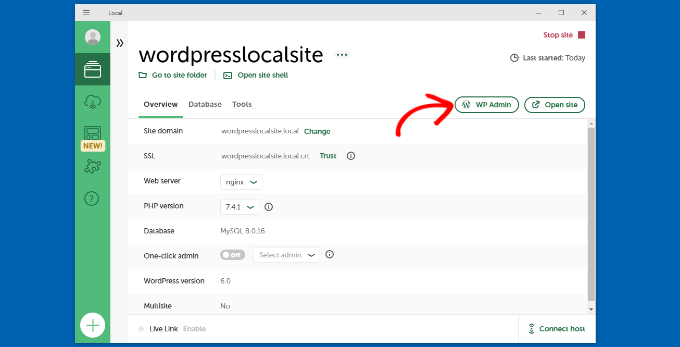
Ensuite, vous verrez la page de connexion à l’administration de WordPress.
Il suffit de saisir le nom d’utilisateur et le mot de passe que vous avez saisis lors de la configuration du site local, puis de cliquer sur le bouton « Se connecter ».
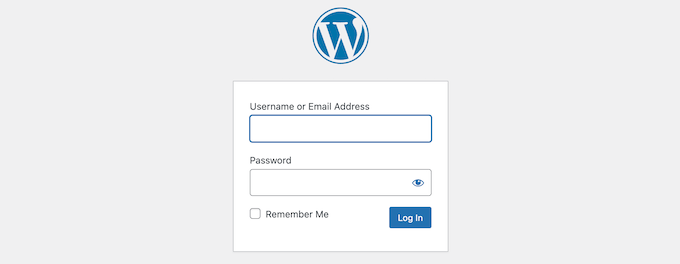
Vous pouvez maintenant modifier votre site local sur votre ordinateur Windows.
Lorsque vous avez terminé, n’oubliez pas d’arrêter le site à partir du logiciel Local WP en cliquant sur le bouton ‘Arrêter le site’.
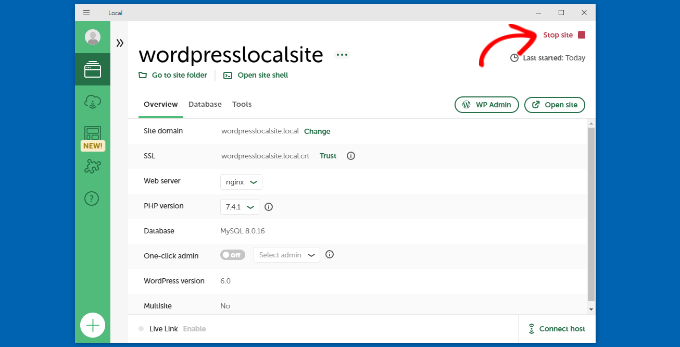
Installer WordPress sous Windows avec WampServer
WampServer ou WAMP est une compilation du serveur web Apache, de PHP et de MySQL lotée pour les ordinateurs Windows.
Ce sont tous des logiciels libres distincts. Cependant, les installer séparément n’est pas très facile, même pour les utilisateurs/utilisatrices expérimentés. Un logiciel comme WampServer vous permet de les installer facilement et de disposer d’un environnement local fonctionnel en quelques minutes.
Tout d’abord, vous devez télécharger le logiciel WAMP et l’installer sur votre ordinateur. Il vous suffit de vous rendre sur le site de WampServer et de cliquer sur le bouton « Start Using WampServer ».
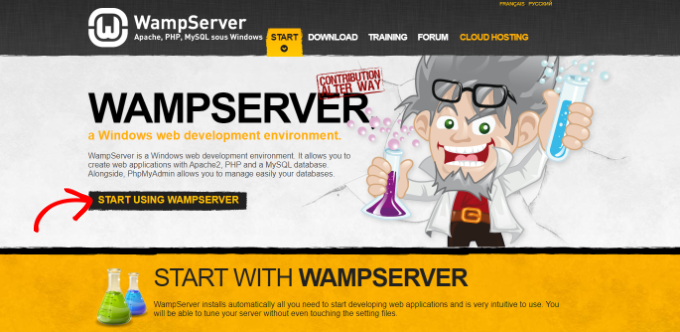
Vous accéderez à la section des téléchargements. Vous consulterez cette page en deux versions : WampServer 32 bits et WampServer 64 bits.
Vous devez sélectionner la version de WampServer qui correspond au type de système d’exploitation de votre ordinateur Windows.
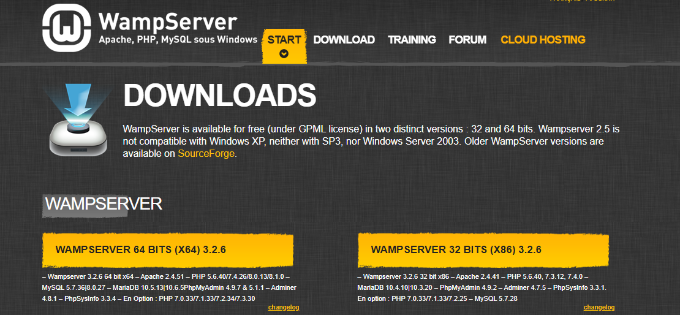
Pour trouver si vous utilisez un système d’exploitation 32 ou 64 bits, il suffit de rechercher « Panneau de configuration » dans la barre de recherche de la barre des tâches Démarrer.
Ensuite, vous pouvez aller dans Système et sécurité » Système de votre ordinateur. Vous pourrez y voir votre type de système.
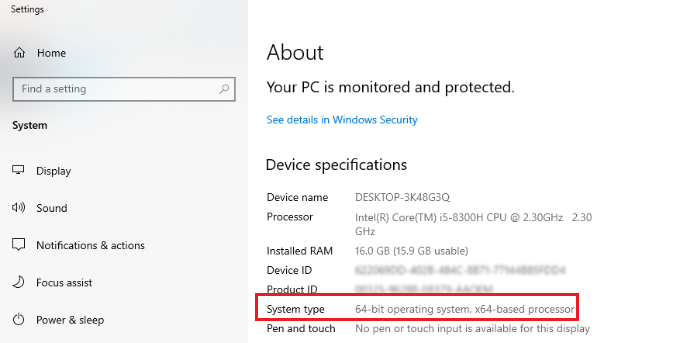
Maintenant que vous connaissez le type de votre système d’exploitation Windows, il vous suffit de sélectionner la version correcte du logiciel WampServer.
Lorsque vous cliquez sur le bouton de téléchargement, un formulaire s’ouvre pour vous demander vos données personnelles. Si vous ne souhaitez pas fournir ces informations, cliquez sur le lien « Vous pouvez le télécharger directement ».
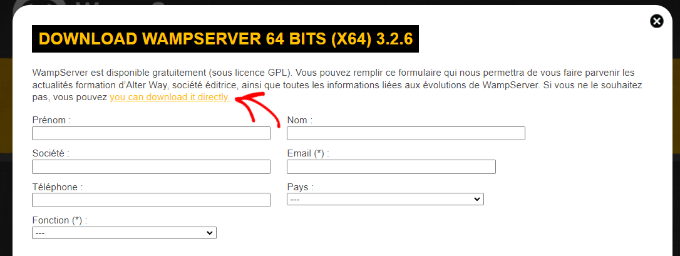
Une fois téléchargé, vous pouvez cliquer sur le fichier d’exécution de WampServer pour lancer l’installation.
Sélectionnez ensuite une langue dans le menu déroulant et cliquez sur le bouton « OK ».
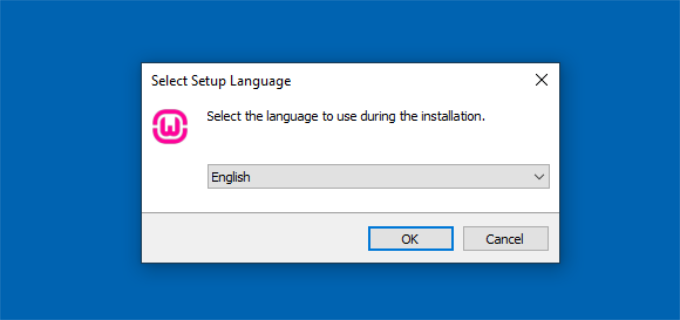
À l’étape suivante, vous verrez apparaître l’accord de licence.
Sélectionnez l’option « J’accepte le contrat » et cliquez sur le bouton « Suivant ».
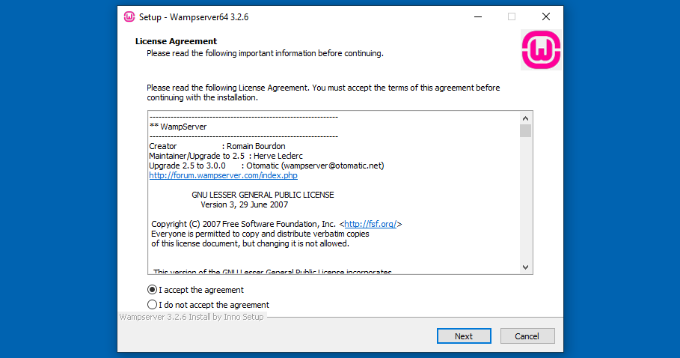
Ensuite, l’assistant de configuration affiche des informations sur l’installation de WampServer.
Vous pouvez simplement cliquer sur le bouton « Suivant » pour continuer.
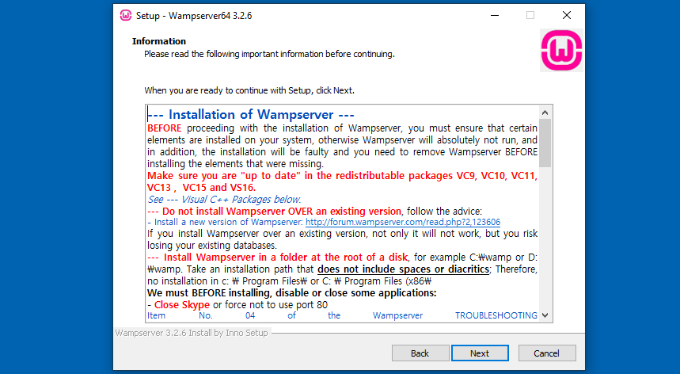
Ensuite, vous pouvez sélectionner l’emplacement de destination où le logiciel sera installé.
Pour modifier l’emplacement par défaut, cliquez sur le bouton « Parcourir » et choisissez le dossier de votre choix. Lorsque vous avez terminé, cliquez sur le bouton « Suivant ».
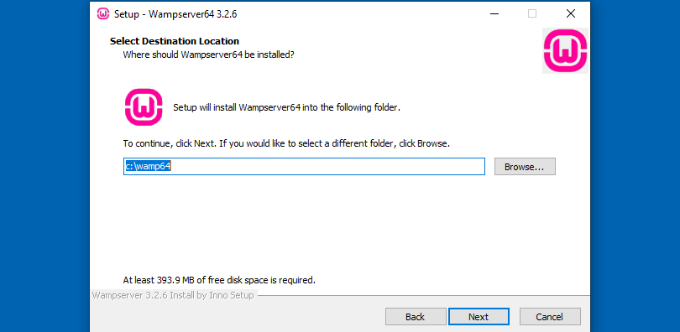
L’assistant de configuration vous demandera de sélectionner les différents composants que vous souhaitez installer. Il s’agit notamment des versions de PHP et de MySQL.
Vous pouvez également conserver les options par défaut et cliquer sur le bouton « Suivant » pour continuer.
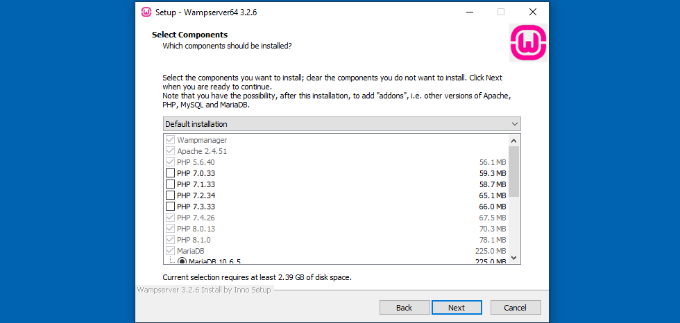
Sélectionné, vous pouvez sélectionner un dossier du menu Démarrer. Cliquez sur le bouton « Parcourir » pour choisir un autre dossier.
Une fois le dossier sélectionné, cliquez sur le bouton « Suivant » pour continuer.
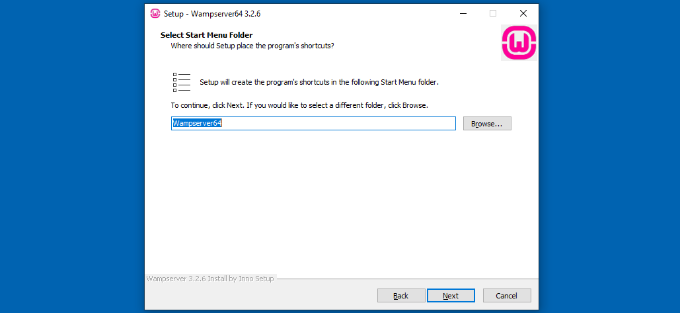
Le logiciel est maintenant prêt à être installé. Vous pouvez consulter un résumé de l’emplacement de destination, du type de configuration, des composants sélectionnés, etc.
Cliquez sur le bouton « Installer ».
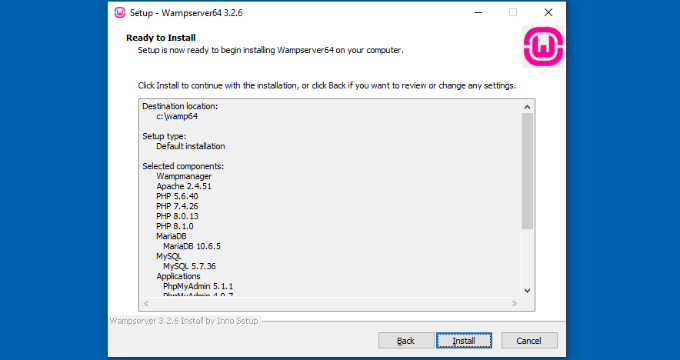
Au cours du processus d’installation, vous devez définir l’Emplacement du navigateur web. Par défaut, il s’agit d’Internet Explorer.
Vous pouvez le modifier pour Google Chrome ou tout autre navigateur web en l’Emplaçant dans le dossier Program Files de votre ordinateur.
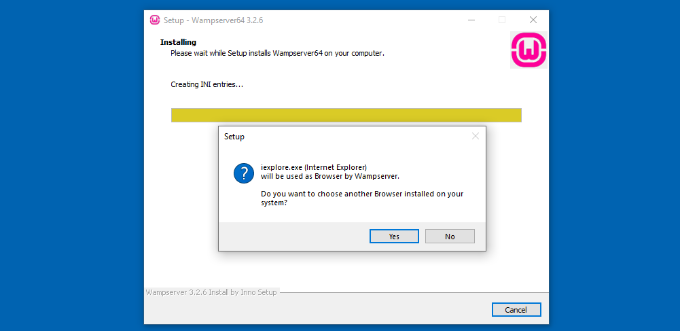
De même, il vous demandera si vous souhaitez utiliser Notepad lorsque vous utilisez WampServer.
Ensuite, l’assistant de configuration affiche des informations sur le fonctionnement de WampServer.
Cliquez sur le bouton « Suivant ».
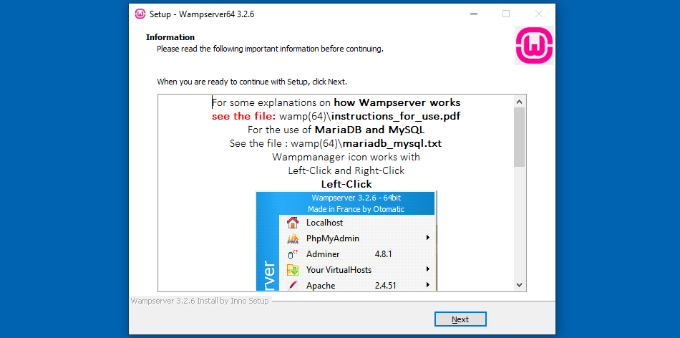
Vous avez bien installé WampServer sur votre appareil Windows.
Cliquez simplement sur le bouton « Terminer » pour quitter l’assistant de configuration.
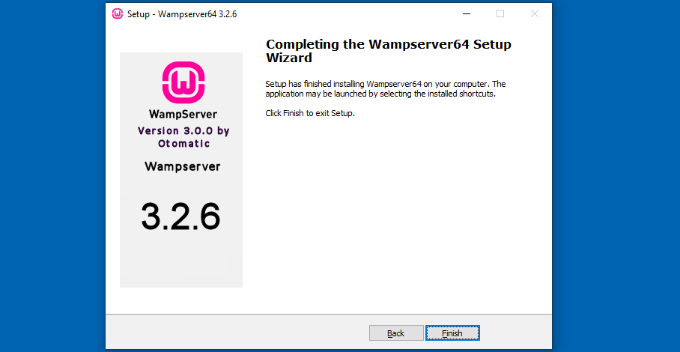
Une fois installé, vous pouvez lancer le WampServer à partir du raccourci de votre ordinateur ou de l’emplacement de destination où vous avez installé le logiciel.
La prochaine chose à faire est de créer une base de données MySQL vierge.
Au lancement de WampServer, vous verrez une icône verte en bas à droite de votre écran, parmi d’autres icônes. Il vous suffit de cliquer dessus avec le bouton gauche de la souris, puis de cliquer sur phpMyAdmin (une application web permettant de gérer les bases de données MySQL).
Note : Si l’icône de WampServer est rouge ou jaune, cela signifie que les services (Apache, MySQL, PHP) ne sont pas en cours d’exécution. Vous devez démarrer les services en cliquant sur l’icône avant de configurer la base de données.
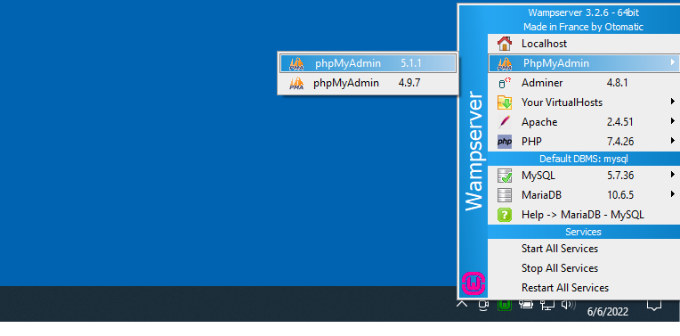
Vous accéderez à l’écran de connexion de phpMyAdmin sur votre navigateur.
Saisissez simplement le nom d’utilisateur : root et laissez le champ du mot de passe vide. Il s’agit des informations de connexion par défaut pour accéder à votre serveur local phpMyAdmin.
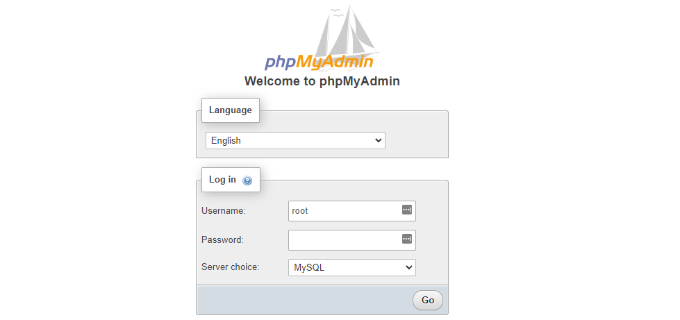
Cliquez sur le bouton « Go » pour continuer.
Une fois connecté, vous devez cliquer sur Bases de données dans phpmMyAdmin pour créer une nouvelle base de données pour WordPress.
Il vous demandera de choisir un nom pour votre nouvelle base de données (nous avons nommé la nôtre test_db). Cliquez ensuite sur le bouton « Créer ».
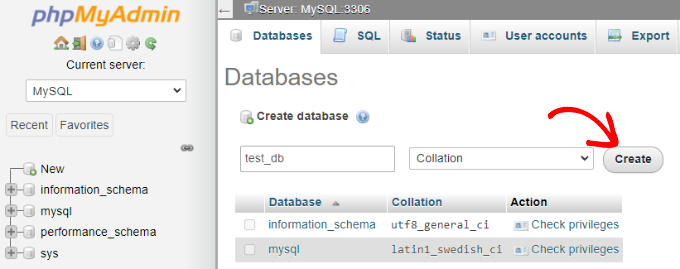
Votre base de données est prête, ce qui signifie que vous pouvez maintenant installer WordPress sur l’hôte local.
La prochaine chose à faire est de télécharger la dernière version de WordPress à partir du site WordPress.org. Elle sera téléchargée sous la forme d’un fichier zip.
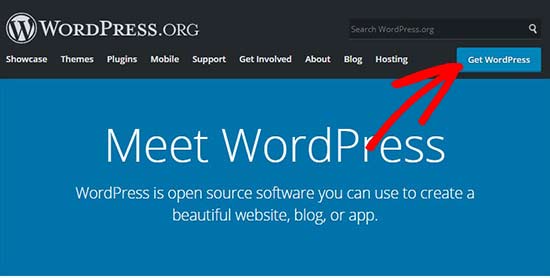
Ensuite, vous devez extraire le fichier zip et copier le dossier ‘wordpress’.
Pour ce tutoriel, nous utilisons WinRAR pour décompresser le fichier. Il suffit de cliquer sur l’option « Extraire vers » en haut de la page.
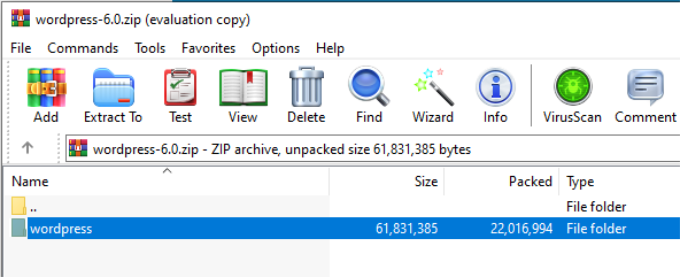
Vous devez maintenant vous rendre dans le dossier où vous avez installé WAMP.
Dans ce tutoriel, nous avons installé WAMP dans C:\Nwamp64, nous ferons donc référence à ce dossier. Cependant, gardez à l’esprit qu’il peut être différent pour vous en fonction de l’endroit où vous avez installé le programme.
Collez le dossier ‘wordpress’ dans le dossier C:\wamp64\www.
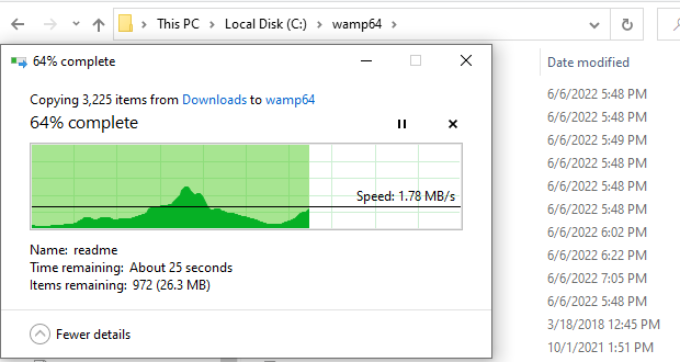
Vous pouvez renommer le dossier « wordpress » comme vous le souhaitez, par exemple mysite, testsite, etc. Il s’agira de l’URL de votre site WordPress local, alors choisissez quelque chose dont vous vous souviendrez facilement.
Pour les besoins de ce tutoriel, nous avons renommé le dossier de wordpress en mysite.
Ensuite, vous pouvez ouvrir le navigateur web et aller sur http://localhost/mysite/ et cliquer sur le dossier ‘wordpress’.
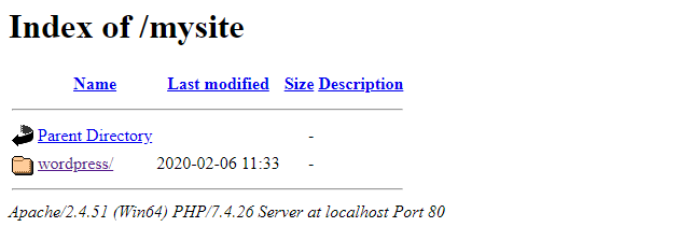
Sélectionné, il vous demandera d’abord de sélectionner une langue, puis affichera les informations relatives à la configuration de la base de données.
Après avoir sélectionné une langue, cliquez sur le bouton « Continuer ».
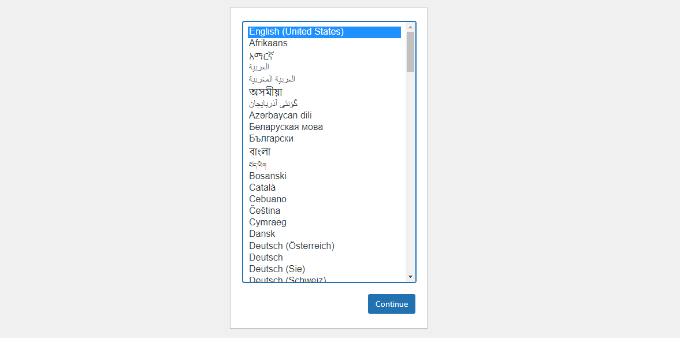
Ensuite, vous verrez une notification de bienvenue sur WordPress.
Une fois que vous l’avez lu attentivement, cliquez sur le bouton « Let’s go » pour continuer.
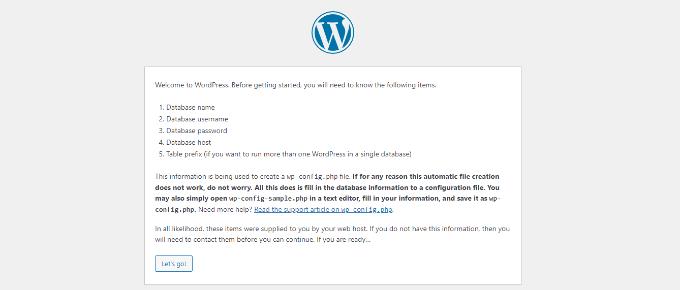
Ensuite, vous devez saisir les données de votre base comme le nom de la base, l’identifiant, le mot de passe, l’hébergeur et le préfixe de la table.
Le nom de la base de données sera celui que vous avez saisi/saisie à l’étape précédente. Dans notre cas, nous l’avons appelée « test_db ». L’identifiant sera ‘root’, et vous pouvez laisser le champ du mot de passe vide. Vous pouvez également laisser l’hébergeur de la base de données et le préfixe de la table tels quels.
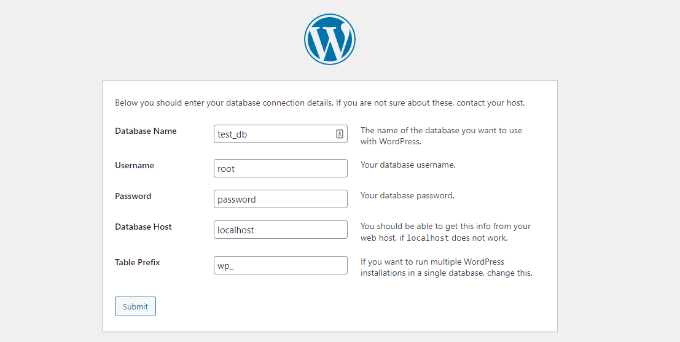
Ensuite, cliquez sur le bouton » Envoyer » et WordPress créera un fichier de configuration pour vous dans l’interface d’administration.
Sur l’écran suivant, vous verrez un message de réussite indiquant que WordPress est connecté à votre base de données, et que vous pouvez poursuivre l’installation.
Cliquez sur le bouton « Exécuter l’installation » pour continuer.
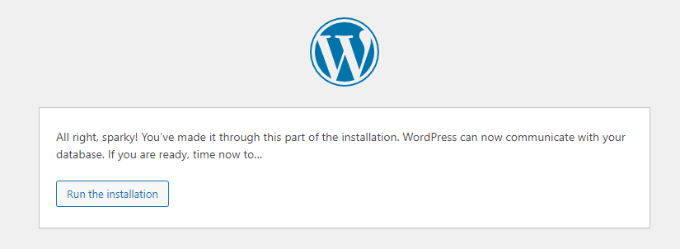
Vous accéderez à l’écran de bienvenue de WordPress. Vous devez ajouter un titre à votre nouveau site WordPress, choisir un identifiant d’administrateur, saisir un mot de passe fort et fournir une adresse e-mail d’administrateur.
Une fois que vous êtes prêt, cliquez sur le bouton « Installer WordPress ».
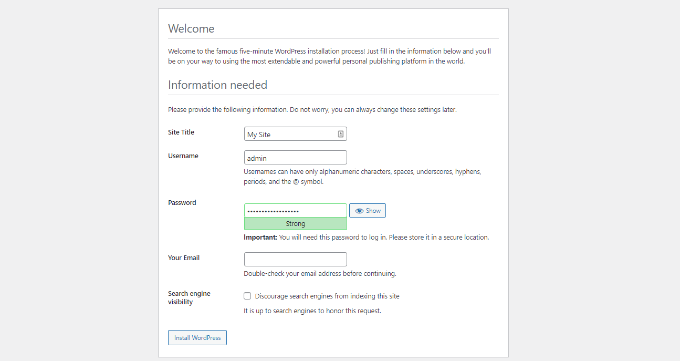
Une fois le processus d’installation terminé, un message de réussite s’affiche. En arrière-plan, WordPress a créé de nouvelles tables dans votre base de données et est prêt à être utilisé.
Vous pouvez ensuite accéder à votre Tableau de bord WordPress en cliquant sur le bouton » Se connecter « .
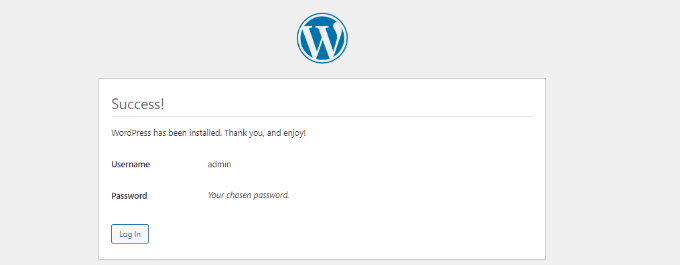
Félicitations, vous avez bien installé WordPress sur un ordinateur Windows à l’aide de WampServer.
Connectez-vous simplement à votre panneau d’administration WordPress et commencez à modifier votre site dans un environnement local.
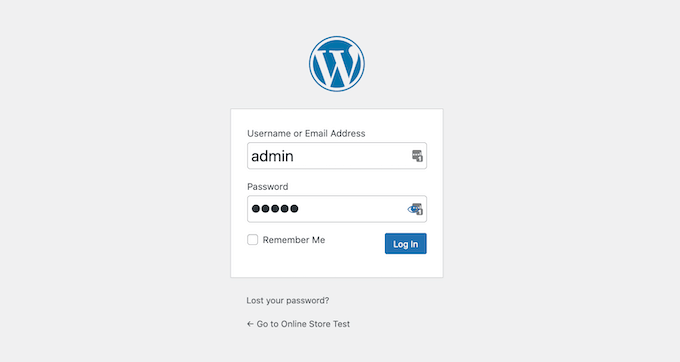
Activation des jolis permaliens dans WAMP
La nouvelle version de WordPress ne casse pas votre site local en modifiant le Réglage des permaliens.
Cependant, si vous voyez toujours l’erreur » page non trouvée » sur vos pages après avoir modifié les permaliens à partir de Réglages » Permaliens dans WordPress, alors suivez simplement notre guide sur la façon d’activer les permaliens personnalisés dans WAMP.
Bonus : Migration de WordPress de Local à En Direct
Nous avons également rédigé un guide séparé sur la façon de déplacer WordPress d’un serveur local vers un site en direct. Nous espérons que vous le trouverez utile lorsque vous serez prêt à déployer votre site local en production.
Disposer d’un environnement de serveur local est idéal pour l’apprentissage et les tests. Toutefois, si vous souhaitez créer un blog WordPress visible par d’autres personnes, vous ne devez pas installer WordPress sur votre ordinateur. Vous devez installer WordPress chez un fournisseur d’hébergement WordPress.
Nous espérons que cet article vous a aidé à apprendre comment installer WordPress sur un ordinateur Windows. Vous pouvez également consulter notre guide sur le référencement de WordPress et sur la façon de créer un magasin en ligne.
Si vous avez aimé cet article, veuillez alors vous abonner à notre chaîne YouTube pour obtenir des tutoriels vidéo sur WordPress. Vous pouvez également nous trouver sur Twitter et Facebook.




Syed Balkhi says
Hey WPBeginner readers,
Did you know you can win exciting prizes by commenting on WPBeginner?
Every month, our top blog commenters will win HUGE rewards, including premium WordPress plugin licenses and cash prizes.
You can get more details about the contest from here.
Start sharing your thoughts below to stand a chance to win!
Bidyut Kumar Mondal says
Thanks a lot for such a wonderful post.
Ali says
Just to say Thank you very much.
sreenu says
thank you…thank you soooooooooooo much ..
Nissim says
Thank you so much. this was sterling
adriana says
OMG i made it through. lol. thank you for your time writing this, it helped me through the panic stage lol
mahendra says
Who help of peoples, They are God
Kenneth Ekeh says
Help please! I have followed the article and installed wamp, created the wp database but culd not be able to run complete configuration of wp. Its telling me « can’t select database ». Try Again. Please help me to fix this. Thanks.
WPBeginner Support says
During the installation when it asks for your database details, please make sure that you are entering the same name for the database which you used when creating database in phpmyadmin. For username, use root and leave password blank.
Administrateur
Tom says
Upon opening mysql workbench, choose your connection, then write the code without quotes « create database nameofyourdatabase; » this will be the name of your database and what you will use in the wordpress setup when it asks for the name of your 1)database(use nameofyourdatabase) 2)username 3)password 4)database host(im using « localhost »)
Hope this helps.
Tammi L. Coles says
Just a quick note of thanks for this very simple-to-follow tutorial. It worked like a charm (including the Apache rewrite for permalinks follow-up).
ogunmakinwa dayohanks. says
Your tutorials as been good for me so far, but please which stable wordpress can i download? can i download the latest version? i am just thinking that some plugins might not be available for the latest version.. so for now which version do you recommend for me? thanks
WPBeginner Support says
We always recommend using the latest stable version of WordPress.
Administrateur
Mohamed Ishag says
Hi there,
Would you please answer the question posted on 12/11/13 I still need help
as I am unable to run the WAMP Server on Windos 8. Please read question posted on 12/11/13.
Thank you in advance.
Regards,
Mohamed
Orestes says
I was able to install WP, but I’d like to know how to manage different web logs within my local server. Thank you for the instructions and tutorials here.
WPBeginner Support says
you can install different weblogs (blogs or websites) on the same server by installing wordpress in different sub-directories inside your
/wamp/wwwfolder. For example:C:\wamp\www\site-1 will open in http://localhost/site-1
C:\wamp\www\site-2 will open in http://localhost/site-2
Administrateur
GinoDC says
After entering details for Site Title, Username, Password and Email I press Install WordPress and my computer hangs. Please help.
WPBeginner Support says
This could happen for a number of reasons. Try to uninstall wampserver and then download and reinstall again. If the problem presists, then you can try XAMPP.
Administrateur
Mohamed Ishag says
Hello,
I have installed WAMP on Windows 8 but I am having a problem creating a data base due to the following error (You don’t have permission to access /phpmyadmin/ on this server). I have edited the htpd.conf file as follows
Open file httpd.conf through wamp tray icon
Find:
# onlineoffline tag – don’t remove
Order Deny,Allow
Deny from all
Allow from 127.0.0.1
Change to:
# onlineoffline tag – don’t remove
Order Deny,Allow
Allow from all
Then saved but still get the same error, why!? Norton 360 is installed on the PC
and no other conflicting apps. I need some help to fix this issue. Any ideas? Thank you in advance.
Best Regards,
Mohamed
Mohamed Ishag says
Dear Syed and the team,
Thank you very much for this site. I am new to WordPress and found your tutorials and explanation very good and straight forward. I feel that you are a busy man but still have time to dedicate this site to new WP beginners. God bless your parents.
Salam,
Mohamed
adam says
Hello,
I have installed everything and am finally at my wordpress dashboard on my localhost machine. everytime i click on visit my site to view what I have changed the page simple directs to the WAMP server configuration screen that shows apache version, php version, loaded extensions, etc… It seems that something simple needs to be changed but I dont know…Can anyone please help? Thanks in advance…
WPBeginner Support says
You have probably installed WordPress in www directory. You need to install it in a subdirectory like www/testsite1/
Administrateur
Nuno says
Hey i have the same problem, so if i just copy all the files to a subdirectory it will work or do i have to reinstall it all over? Thanks.
Matthew says
Thank you, than you, thank you. I am a technophobe and your clear instructions helped me all the way.
Arthur says
Hi,
After installing WAMP in accordance with your instructions, I could not open phpmyadmin; explorer kept waiting for localhost. I’m not a pc techie so I desperately need instructions how to proceed furter in the same easy way as your manual above. I have a 64 bit W7 machine, and installed the 64 bit version of WAMP first, but since that did not work as described , I installed the 32 bit, but with the same result. Thanks for your help in advance ! (No Skype, port 80 OK, as far as I can see)
WPBeginner Support says
Try restarting all services make sure that WAMPServer icon is green also make sure that Skype is not running in the background. Also look at this support thread for more possible solutions.
Administrateur
Arthur says
Thanks a lot: I followed your recommended thread and I removed a double line in the Host file (‘127.0.0.1 Localhost’) that seemed too much and now I can get to a log-in page of phpMyAdmin, which is great, but I have not yet even entered an ID and password during initial installation of WAMP. Did I miss something ?
Thanks for your patience again…
WPBeginner Support says
To log in to phpMyAdmin, enter username root and leave password blank.
Trudy Ritsema says
Can I run more than 1 test site on WAMP? and any ideas of how I would go about this please?
I already I have localhost site running – and I don’t want to get rid of that yet as I am still developing it…
Thanks in advance.
WPBeginner Support says
in your www directory create new directories for each website. That way you can run multiple sites on localhost.
Administrateur
viki says
i can’t create new database, bcause it is showing » * No Privileges » in red colour letters. please help me
WPBeginner Support says
you are probably entering wrong credentials to connect to your mysql database.
Administrateur
nick mav says
you should login using the following credentials:
username: root
password: [empty] –> that is, no password
Shawn Morrissey says
Thanks Nick,
I had the same issue and couldn’t find this out anywhere I had looked previously…
SanketP says
Hi. I am a new-bee to this world of eb designing. Wanted Joomla but that didnot go thru too well. WP instal was as good for me. Thank you. XOXOXO.
Everett says
Hello. I want to be able to develop my wordpress site locally and not have to be connected to the web when I make changes and do save or update inside wordpress. Before I go through all the installation of WAMP and WP locally, can anyone tell me if I will have to have internet access to make updates to a wordpress running locally in WAMP? Sure I realize if I wanted a new Theme or Plugin, I would have to be online, but if I am just making adjustments to text and adding pictures that are already on my laptop, etc. will I have to have internet access to do so? I ask because I do a lot of travel where I am on an airplane and could be working on a new version of a website if I don’t have to be online. Also, I can’t afford a wireless account for my laptop, so I only have internet when I am at home with my own wifi or when I am somewhere that has a free wifi. Thanks.
WPBeginner Support says
no you do not need an internet connection to work locally on your website.
Administrateur
Ian says
I followed the instructions to the letter, installed WAMP and the required SP1 Visual C++ on a brand new laptop running Windows 8 64bit. The installation refuses to launch, brings up a screen asking if I’m sure I want to let this programme make changes to the computer, then does nothing when ‘Yes’ is clicked. What is going wrong?
WPBeginner Support says
Does the wampserver icon appear in your windows taskbar? If it does, then you need to click it and launch wampserver.
Administrateur
Brynn says
Please help. I installed WAMP but when I went to open phphMyAdmin, nothing happens. I tried uninstalling and reinstalling, but still getting the same problem. I’m not even getting any sort of popup block notification in my browser. Just nothing.
I wonder if this might have something to do with the WARNING window that popped up on the WAMP website before I downloaded it… It said something in French, and then something about needing to install C++ which I know nothing about, and which was not mentioned in this tutorial.
Do I need to install C++ and if so, do I need to learn how to use the programming language before I can finish this tutorial on installing WordPress? I am a designer, not a programmer, so I hope to god I don’t need to stop everything and go learn C++ before I can do a simple WordPress install.
WPBeginner Support says
Brynn you can always check whether or not Microsoft Visual C++ is installed on your computer from Control Panel -> Programs and Features. Do you see wampserver page when you visit http://localhost? If you do, then you have already successfully installed WAMP.
John Victor says
Can I hug you now or later?
Anudeep says
Awesome tutorial
guru says
I install wordpress to my localhost. But i dont know to use it to develop a site. I’m new to wordpress. Please anyone help me.
WPBeginner Support says
Take a look at our beginner’s guide section. For theme development you may want to take a look at our WordPress theme cheat sheet for beginners.
Administrateur
Scott Cho says
Got WAMP installed, but when I try to create a new databse by clicking on the phpMyAdmin button in WAMP the chrome browser window that opens up says:
Forbidden
You don’t have permission to access /phpmyadmin/ on this server.
Can anyone point me in the right direction as to what this is and how to fix it? I don’t know if this makes a difference but I have it installed on my secondary hard drive, not my C drive (the c drive just has my operating system).
Asad Riaz says
Here is how you edit the htpd.conf file
Open file httpd.conf through wamp tray icon
Find:
# onlineoffline tag – don’t remove
Order Deny,Allow
Deny from all
Allow from 127.0.0.1
Change to:
# onlineoffline tag – don’t remove
Order Deny,Allow
Allow from all
Plus resolution to some other conflicts
Make sure no other program conflict wamp such as Xampp, phpEasy, IIS, Skype, Zonealarm, firewall/antivirus, NOD32, Eset, any web and/or Remote Desktop related program, such as Teamviewer …
IIS and Apache/Wamp are both web server and might conflict in some way, so you have to disable IIS in order for Wamp to work
Disable IIS in Vista/W7:
Control Panel, Uninstall Programs, Turn Widows Features On or Off, uncheck Internet Information Services
Disable IIS in XP:
Control Panel, Add/Remove Programs, Add/Remove Windows Components, uncheck Internet Information Services (IIS)
Restart computer, then restart Wamp
Also, in folder C:\WINDOWS\System32\drivers\etc, open file hosts and delete anything in this file and have only this line below and nothing else
127.0.0.1 localhost
If using Skype, go to Tools->Options->Advanced->Connection and uncheck the box « Use 80 and 443 as alternatives for incoming connections ». Restart Skype after WAMP. Now you will be able to use both programs at the same time w/o problems.
I hope it helps, found it on net
Asad Riaz says
Howdy,
Well i have managed to install it using the article. Some info was missing in this article like
1. Once you click on phpMyAdmin, it asks for login details, so here they are:
username: root
pass: (leave it blank)
2. WAMP sometimes gets offline and it wont open the phpMyAdmin page, so you guys need to edit the htpd.conf file in C:wamp/bin/apache4.2/conf/htpd
Lets see now how much it helps me.
I m here for all the support that i can extend.
Thanks to the author of this page.
Cesar M. says
thanks for the user info I was getting crazy, but I finally got in to phpmyadmin
Colin Teasdale says
Hiya,
Problem solved – I had needed to install the Visual C# redistributable, and did that after installing Winamp. Uninstalled Winamp, rebooted and then re-installed – everything fine. That’ll be user error then ! ! !
Colin T.
Scott Cho says
I’m getting the same error you just described below, where is this redistributable you speak of?
Colin Teasdale says
Hi guys,
I’ve just downloaded and installed WAMP and have got to the « set up a database » stage. When I select ‘phpMyAdmin’ I get a ‘Firefox Problem Loading Page’ page with « Unable to connect – Firefox can’t establish a connection to the server at localhost ».
I’ve tried the fix suggested by Imran on June 17th, but this doesn’t seem to have fixed resolved the problem.
Any thoughts on how I fix this, please??
Peter says
Hi Editorial Staff,
Do you have a tutorial that is the reverse process also using WAMP? I have a functioning website that I would like to duplicate on my home computer for experimenting and learning css, and php programming without risking my functional website.
Thanks.
EL says
That is exactly what I need!
Denzil says
Hi, a very useful article, thanks. Is it easy to migrate a test WP site on WAMP to a hosted site elsewhere? Do you have a tutorial article to help?
Thanks
Editorial Staff says
Yes, it is fairly easy to do that. Tutorial will be coming tomorrow
Administrateur
Denzil says
Great! How timely! Thanks guys, looking forward to it.
Kate BP says
Absolutely cracking article – really helpful, thanks so much!
akash says
After clicking on phpmyadmin,,,,,,,
i am getting redirected to directly php my admin webpage and not the database entry option which is shown above.
thereafter the details are not matching afterwards in database,username and password.please give me its solution as soon as psbl.
Amitoj Gautam says
User Name: Root
Password: None (Leave this space empty)
Click on the Go button. You will be directed to the page you are looking for.
Dana says
Hi! Once I’ve created a site on my WAMP server, could I then transfer it to an existing domain name? I’m trying to create a new site without shutting down the old one. Once the new one is finished, I would want to replace the old one, but use the same domain name. Thank you!
Editorial Staff says
Yes you can do that. We have updated the article to add a link to the tutorial.
Administrateur
vahid says
Thank you so much
chris martin says
Hi, I am having trouble with links not working. Could you help me or give me some direction on how to fix that? On my site « chrisjamesmedia.com » click menu, then « blog » and i get « not found ». This also happens with links as well.
Also, do you have a tutorial on how to host multiple domains from this as well, or point me in the right direction.? I have looked up several things about virtual domain, localhost, and everytime I find something they want me to edit httpd conf, but what they have doesnt match mine.
Thank you so much!!!!
Tamsin says
Hi,
Great article, very clearly explained.
Would you be able to tell me the best way to add a second WordPress site to Wamp? I have read a lot of conflicting information and would rather not make a massive mess of things!
Editorial Staff says
Create a new folder inside your www folder, then repeat this process.
Administrateur
Tom Smith says
Hi,
Thank you for providing this excellent tutorial! It’s going to be great to get use to using WP onn my PC before I install it on my host server and create my website.
I followed your instructions and installed WAMP and then WordPress and got all the screens you showed here… and with the tweaking you suggested, I was finally able to open WP – saw the Dashboard, etc. Then I closed it.
But now I can’t seem to open WP. I open WAMP and click on Localhost – and it just sits « waiting for response from localhost » – does not open anything. I’ve tried http://localhost/my database name – it will not open – I get « HTTP 500 Internal Server Error ». Just in case, I also followed your instructions on SKYPE and unchecked that Port 80 box.
What am I missing?
Editorial Staff says
Did you shut down your computer? You have to launch WAMP Server every time you restart your computer.
Administrateur
Imran says
When i try to Setting Up a Database for WordPress, it was saying like this : Forbidden
You don’t have permission to access /phpmyadmin/ on this server. what is the reason ? can you please guide me. thank you in advance….
Editorial Staff says
That’s weird. Since you are the admin of your Wamp install, then you shouldn’t get this error.
Administrateur
Imran says
Finally i got the solution…
I think it will be useful for others.
for phpmyadmin
Goto c : wamp/alias/phpmyadmin.conf file, open with notepad.
find
Options Indexes FollowSymLinks MultiViews
AllowOverride all
Order Deny,Allow
Deny from all
Allow from 127.0.0.1
replace with
Options Indexes FollowSymLinks MultiViews
AllowOverride all
Order Deny,Allow
Allow from all
thats it…
Imran says
Thank you very much EDITORIAL STAFF, this is a nice post and very usefull.
Melanie says
I had this same problem with the phpmyadmin and I found and made the changes cited here to the alias file, then restarted WAMP and I was able to create my database. However, now I’m getting the same Forbidden message when I try to install WordPress on my localhost, exact text below:
Forbidden
You don’t have permission to access / on this server.
I can get to the WP install screen from 127.0.0.1, but not localhost. I’m running Windows 8. Any ideas on how to get this to install? Thanks in advance for any help you might be able to give me.
Akshay says
Hi.
I wanted to use this method to test out plugins before installing then on my live site. So in your tutorial, instead of copying in clean WordPress files, I copied in a full backup of my site made using BackupBuddy.
However from this point on I’m not sure what to modify in order for my site to function correctly offline. I edited my wp-config file to the new database details, and imported my database from my online phpmyadmin to the WAMP one. However it seems like there’s something I’m missing, as when I try to access localhost/site/wp-admin I am redirected to my online login page.
Do you have any suggestions?
Thanks very much for your help.
Akshay
Brandi says
I’m in the same boat – did you ever find a solutions?
Christophe R. says
Another (lazy) point for XAMPP : I know there are some differences in the config files, but I use both linux (at home) and Windows (Seven and 8) at work, so I appreciate having the same interface for I only have to learn once.
Andre says
Great article and easy instructions for those who want to venture into WAMPP….however, for myself, I still prefer XAMPP and do run it on it’s own on a second drive without the installable version. Updating is a breeze, although I rarely need to.
I’ve used XAMPP for many years now for both WordPress and Joomla theme development, as well for a testing server. Never had issues and I do find it quite easy to use. I used to use the full version but I found that the Lite version works extremely well.
I noticed someone said AMPPS, but I’ve never tried that…perhaps in my spare time I will try it out.
Nicholas says
Its click and install that’s how easy it is and just open to localhost/ampps i use it for all my scripts that this includes as downloads and install on the service. no worries on xamp and wamp that i found to limited in some ways.
Adrian says
Thanks alot it was really helpful
Thomas says
Hi everyone,
I’m a very beginner with WordPress and I have created a site with it and WAMP on my computer.
Now I want to put it online, but I don’t know how to do it.
Where does a tutorial exist for that?
The thing is that I want to replace the current site, which is hosted somewhere else, and so keeping the domain name.
Does anyone know where I can find this kind of information?
Thanks a lot!
Nicholas says
WAMP in the older days was great! Now there is a far more better and less embarrassing way when it comes to configuring things with WAMP. WAMP is in the past and gone for me. I use AMPPS far more better no configurations, just install and a few dips of changes in the options section that’s it. Open your browser go to your localhost and install any cms or other scripting lang within your browser using ampps. You’ll be amazed! No more downloading then extracting in www folder and then reconfiguring. WordPress is just a click and install on ampps. No hassle! Shouldn’t you guys write something about AMPPS? This is a lot more better than WAMP! WAMP lags a lot of things like cgi and stuff those are extras, but on ampps everything is included. Ever since ampps I never looked back to wamp! Sorry!
Editorial Staff says
Have been using WAMP for so long that didn’t even bother with another option. AMPPS sure looks good. Good to see that it is made by the folks from Softaculous. Will have to give it a try.
Thanks for the suggestion Nicholas.
Administrateur
Zimbrul says
Why do you say you prefer WAMP over XAMPP?
Alexander Gounder says
WAMP is much simpler and easier to use compared to XAMPP.
Editorial Staff says
Would second that. WAMP is easier to use. Several years ago when we used XAMPP the upgrade process was complicated and it was buggy. We switched over to WAMP and it was awesome.
Administrateur
Parth S. says
Hi, Thank you very much for this. It’s very informative and easy to follow. However I’d suggest you mention the skype thing a lil early around the localhost point, because, there ppl start to worry when they see a blank screen with skype on in their PC.
Great post though. Keep it up.
Mladen says
Just to mention, that Team Viewer also causes problems with WAMP.
Christophe R. says
I actually do prefer XAMPP and DTX-Control for I can overcome security policy : Installation without administration rights (zip file pour the web server) and full access to blocked ports (80, 443, 3306).